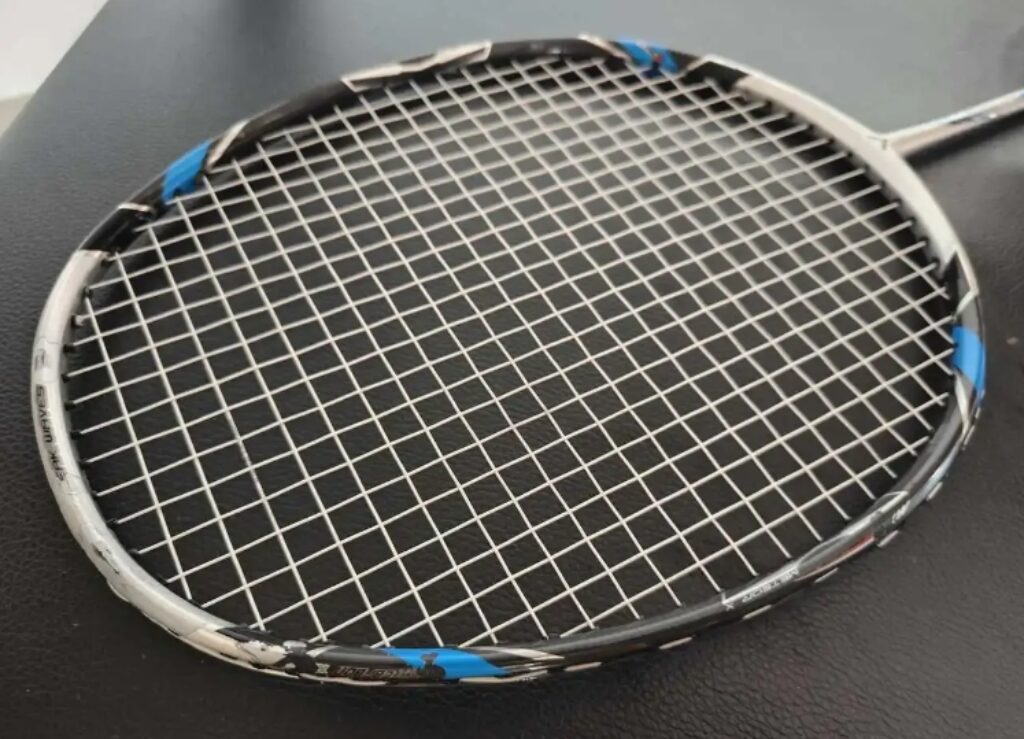Why doesn’t anyone use it? Why doesn’t anyone use it? Why doesn’t anyone use it?
It’s been a long time since I’ve felt this frustrated, but I really don’t understand the situation with this racket. In terms of strength, it’s no worse than the MX80, and in terms of fame, even Vietnam’s top player Nguyễn Tiến Minh has used it. As for its value for money… well, I’m not familiar with its pricing.
The MX70 doesn’t even have detailed reviews in the badminton equipment database, despite the MX80’s brilliance. It’s not as if the MX70 should be so overlooked, especially when even the MX30L gets more attention!

Specifications:
Weight: 3U G5, no grip, total weight when in use 94.5g, balance point 302mm, shaft thickness 7.2mm, shaft length 215mm, stiffness: high.
Frame: octagonal aerodynamic frame, 80-hole string bed, grooves at 9-3 points.
String tension: 28–30 lbs recommended, strung at 28–29 lbs with BG66U.
This is a silver sword… oops, I mean, this is a sharp, silver racket exuding a sense of purity and strength. Although the sample I have shows some wear with stickers peeling and paint chipping in multiple places, it’s clearly been through some tough battles, as seen from the handle and grommet condition. However, upon close inspection, there’s no damage to the carbon fiber frame. The thick frame and shaft give the MX70 a rugged, veteran look. The design carries on the high-end style of the peak series, with visually rich layers.

Speaking of which, this racket has a substantial feel. I’ve been testing it alongside the notoriously heavy 4U TK 75C (stay tuned for that review). Despite the slight weight advantage, the MX70’s heft is noticeably felt in the hand, with a very straightforward head-heavy feel. Oddly, though, its balance point and the feeling during swings don’t align with the perceived weight—it swings quite smoothly, perhaps because it’s set up more as a balanced racket, with a degree of flexibility.
With high string tension and the pairing with BG66U, I immediately felt the “right” connection during the first few long rallies of warm-up. The shaft is not particularly long, and the stiffness is slightly lower than the MX80N, but with a bit of power, you can feel the shaft flex. I wouldn’t say this racket is easy to handle; the stiffness and vibration alone will deter many. However, its core appeal, much like the solid feel of the thick shaft, is its stubborn yet captivating nature, making me enjoy using it.

Power overwhelms technique, and that’s the case with rackets too. Compared to today’s rackets that boast flexible 6.6-6.0mm shafts to create explosiveness, the MX70 reminds me more of the classic VT series from Yonex. It doesn’t offer that “boing-boing” elasticity, but with a stiffer frame, a harder shaft, and a higher balance point, it transmits energy with minimal loss when you fully engage your strength.
Indeed, the direct and raw power in smashes is where you need to handle it carefully. On one hand, the head-heavy balance and strong anti-torsion frame give excellent stability and confidence in smashes, drop shots, and drives. On the other hand, the stiffness and energy-draining setup mean players lacking strength or endurance will struggle by the end of a match. No wonder only the most relentless players use it.

Compared to the MX80N, the slight decrease in stiffness and the increased balance point provide more leverage, making it lean slightly towards a control-oriented playstyle, emphasizing long rallies and strategic maneuvering. As always, the 80-hole string bed delivers great feel, enhancing the solid sensation in net play like pushes, cuts, and drops. Since opponents still fear its power during attacking strokes, the stability of lifts also becomes a key advantage, making deceptive shots and net flicks feel threatening.
However, I tested it primarily in doubles, which presented some unique challenges. First off, I definitely wouldn’t recommend using the MX70 with beginners.

As I initially noticed, this racket is indeed not fast, but it still offers decent agility in quick exchanges. Due to the stiff shaft and string bed, shot response is very quick, allowing you to hit with force and control. The shaft requires almost no time to recover after flexing, making drives and flat shots remarkably stable.
When defending against smashes, the MX70 also excels in repelling powerful shots back to the baseline with ease. But because of the higher swing weight, it becomes more taxing when handling some defensive shots or when reaching for backhand shots, making them harder to execute cleanly. Moreover, the racket’s overall high load during play means it’s physically demanding to use for extended periods. After three hours of testing, my forearm muscles began to ache shortly after leaving the court.

Essentially, the MX70 feels like an adjusted version of the MX80, with a heavier head and a slightly more flexible shaft, making it easier to generate power when smashing. The adjustments give it a slightly steadier feeling in both attack and control, but it’s still incredibly satisfying to use. I’d recommend any fans of the MX80 to give the MX70 a try if they get the chance.

Leave a Reply